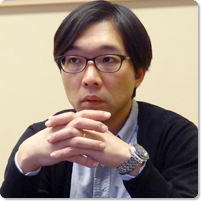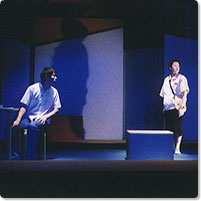Penguin Pull Pale Piles
One Man Show
(Aug. 2003 at THEATER/TOPS)
Data
:
First Performance: 2003
Performance time: Approx. 1 hr. 50 min.
Acts / Scenes: 6 acts, 16 scenes
Cast: 8 (4 men, 4 women)
Yutaka Kuramochi
One Man Show

Yutaka Kuramochi
The playwright was born in 1972 in Kanagawa Prefecture. Graduated from the Economics Department of Gakushuin University. Began acting, playwriting and directing as a member of the college drama club in 1992. In 1994 he appeared as an actor in the production of Ice Cream Man directed by playwright, director and actor Ryo Iwamatsu for young actors. After that, Kuramochi was mentored by Iwamatsu as a playwright and director. In 1996, Kuramochi joined in the founding of the theater company Puriseta with actors Masahiro Toda and Shoichiro Tanigawa. Until quitting the company in 2004, Kuramochi served as the playwright and director. In 2000 Kuramochi started his own theater company Penguin Pull Pale Piles (PPPP), after which he did the writing and directing for all of the company’s productions. Writing with a uniquely cynical viewpoint and the ability to weave rewardingly subtle dialogue, his plays skillfully create an atmosphere similar to theater of the absurd with sudden appearances of the other worlds that exist back-to-back with everyday life. As a director, Kuramochi is recognized for his productions’ imaginative stage art that helps create bold and tricky theatrical worlds within clearly restricted spaces. Kuramochi also applies his skills to adaptations and stage scripts based on existing works ranging from novels to Noh and Kabuki plays. Recently, he has also expanded his activities to scriptwriting for TV dramas and comedy routines. In 2004, his play One Man Show won the 48th Kishida Drama Award.

The audience must take hints from such as key words in the dialogue or sound effects like the sound of water or actions of the characters such as making phone calls, in order to piece together the events and time sequence of the story in their minds.
As the story approaches the end all the pieces fit perfectly together and the thrill of the moment when the entire image of what has happened comes together is one of the attractions of this play.
The following are the pieces of the jigsaw puzzle that the audience is given to fit together as the play progresses.
The protagonist, Ayumu Aoi, is obsessed with sending in postcards to try to win sweepstakes prizes and is so absorbed in his mania that he can hardly find time to sleep. He fills out the postcards in detail, believing that adding information not even requested he increase his chances of winning. Eventually he begins borrowing the names of people around him to increase his number of applications, spending all day in his solitary room creating false hobbies, character traits and family members to fill in his imaginary applicants’ postcards with.
Ayumu’s job is flying over the city and taking aerial photographs to inform the authorities of any changes he finds. One day he visits the Sato home where a room has been added even though no building permit has been filed for. The owner of the house is always out and it is his wife, Hiromi Sato and her husband’s younger brother, Tadashi, who always receive him. Ayumu begins to suspect that the owner of the house doesn’t actually exist.
Ayaumu’s wife, Yukari, has not been taking the postcards her husband gives her to the post office, merely stashing them in a cardboard box. She asks her brother, Akata Shirane, to take the box of postcards and dispose of them somewhere.
The jobless Akata has also been asked to do a job by a woman named Iyero who works in the local government office. The job, which is actually a request by a woman named Midori Midorikawa, is strange in nature. “A man will be coming soon to ask questions about me and I want you to say that you know nothing about me.”
Midori lives with her husband Kuroo in the house next to the Satos. Kuroo believes that the pond in the Satos’ garden is gradually growing bigger and watches it every day.
Meanwhile, through someone’s mischievous act, the box full of postcards that Akata disposed of in the hills has returned to the Aoi’s front door.
This puzzle of events conveys the message to the audience that reality is an unknowable quantity that has as many faces as the people involved who must interpret it. What’s more, in the course of the play the perspectives of character A and character B become confused, leading event X to be depicted as events X’ and X’’.
Then, at the end of the play we learn that all eight of the characters in the play are actually creations of a man hidden away in the added room of the Sato home filling out sweepstakes postcards. In other words, it has all been literally a “one man show.”
Related Tags

